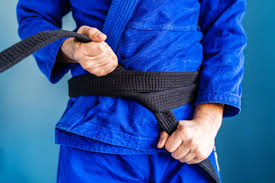Tying your jiu jitsu belt is an important part of your training. Not only does it keep your gi top in place, but it also symbolizes your progress in the martial art. However, tying a jiu jitsu belt can be a bit confusing for beginners. In this guide, we’ll go through step-by-step instructions on how to tie your jiu jitsu belt and explore different styles of belt ties. By the end of this article, you’ll be able to tie your belt with confidence and style.
Why Tying Your Jiu Jitsu Belt Correctly is Important
Tying your jiu jitsu belt correctly is important for several reasons. Firstly, it keeps your gi top in place during training, preventing any wardrobe malfunctions. Secondly, it’s a sign of respect to your training partners, instructors, and the art itself. Lastly, the way you tie your belt can also reflect your rank and experience in jiu jitsu.
How to Tie Your Jiu Jitsu Belt Step-by-Step:
To tie your jiu jitsu belt, follow these step-by-step instructions:
- Take the middle of the belt and place it over your belly button.
- Cross the two ends of the belt behind your back and bring them to the front.
- Make sure that the end on your dominant side is about six inches longer than the other end.
- Wrap the longer end around your waist and tie a simple knot.
- Make sure that the knot is centered and snug.
- Take the longer end and tuck it under the shorter end, creating a loop.
- Bring the longer end over the shorter end and thread it through the loop.
- Pull both ends to tighten the knot.
Different Styles of Belt Ties:
There are several different styles of belt ties that you can choose from, depending on your personal preference and the traditions of your gym or academy. Here are some of the most common styles:
- Basic Knot: This is the most common way of tying your jiu jitsu belt. It’s simple, secure, and easy to adjust if needed.
- Square Knot: This knot is similar to the basic knot, but it’s tied with an extra twist, making it more secure.
- Kung Fu Knot: This knot is a bit more intricate and stylish. It’s similar to the basic knot, but with an added loop on one side.
- Double Wrap Knot: This knot is ideal for those with shorter belts. It involves wrapping the belt around your waist twice before tying the knot.
- Samurai Knot: This knot is the most complex and ornate of all the belt ties. It involves creating several loops and twists before securing the knot.
Tips for Maintaining Your Jiu Jitsu Belt:
After tying your jiu jitsu belt, it’s important to maintain it so that it lasts longer and looks good. Here are some tips on how to do that:
-
Wash your belt regularly: Just like your gi, your belt can harbor bacteria and sweat if it’s not washed regularly. It’s recommended to wash your belt after every training session to keep it clean and fresh.
-
Hang your belt to dry: Don’t put your belt in the dryer as it can shrink and lose its shape. Instead, hang it to dry in a well-ventilated area.
-
Avoid tying knots too tightly: If you tie your knots too tightly, it can cause unnecessary wear and tear on your belt. Plus, it can be difficult to untie.
-
Don’t tie knots in the middle of your belt: This can cause the belt to wear unevenly and fray in the middle.
-
Don’t wash your belt with bleach: Bleach can weaken the fibers in your belt and cause it to deteriorate faster.
By following these tips, you can maintain your jiu jitsu belt and extend its lifespan. Remember, your belt is a symbol of your hard work and dedication to the art of jiu jitsu, so treat it with respect.
Proper Etiquette for Tying Your Belt in Class
While it’s important to know how to tie your belt properly, it’s equally important to follow proper etiquette when doing so in class. Here are some tips to keep in mind:
-
Always tie your belt before class starts: This shows respect for your instructor, your training partners, and the art itself. Don’t be the person fumbling with your belt while the rest of the class is ready to start.
-
Face away from the instructor: When tying your belt, face away from the instructor and towards the wall or the center of the mat. This is a sign of respect and humility.
-
Keep it tidy: Make sure your belt is neatly tied and tucked in. Avoid having a long tail dangling down or a messy knot that can come undone during training.
-
Don’t flaunt your rank: Avoid adjusting your belt constantly to show off your rank. Your training partners and instructor will respect you more if you focus on your technique and attitude rather than your belt color.
-
Don’t step on your belt: Accidentally stepping on your own belt can be seen as a sign of disrespect. Be mindful of where your belt is at all times and avoid stepping on it.
By following these simple guidelines, you’ll show respect for the art of jiu jitsu and your fellow practitioners.
How to Tie Your Belt for Competition or Grading Exams
When it comes to tying your jiu jitsu belt for competition or grading exams, there are a few things you should keep in mind to ensure that your belt is tied securely and properly.
Firstly, make sure to use a knot that you are comfortable with and that will stay tied throughout your match or exam. Some popular knots for competition and exams include the square knot, the double knot, and the triple knot. Experiment with different knots to find one that works best for you.
Next, ensure that your belt is tied evenly and snugly around your waist. A loose or unevenly tied belt can not only be distracting during a match, but it can also be a safety hazard. To prevent this, adjust your belt so that it is snug but not too tight, and ensure that the ends of the belt are of equal length.
It’s also important to remember that some competitions or exams may have specific rules or regulations regarding belt tying. Make sure to check with the event organizers or your instructor to ensure that you are following the correct protocol.
Finally, practicing tying your belt under pressure can help to build confidence and ensure that you are prepared for competition or grading exams. Consider practicing tying your belt while under a time limit, while wearing gloves or while being observed by others to help simulate the pressure of a competition or exam situation.
Hey there! Just a heads up that some of the links in this post are affiliate links, which means that if you click on them and make a purchase, I may earn a commission. But don’t worry, it won’t cost you anything extra – in fact, you might even get a sweet deal! Plus, every purchase made through one of these links helps support my blog and keep the content coming. So, if you do decide to make a purchase, thank you so much for your support – it means the world to me!
All the best,
Will







